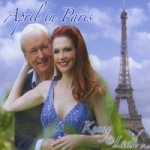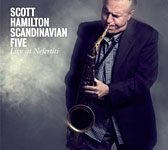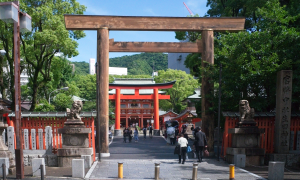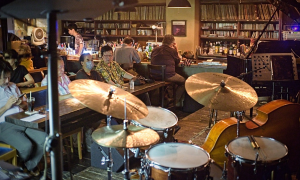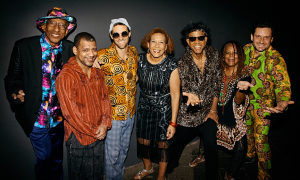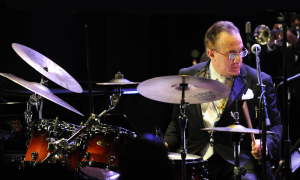Home » Jazz Articles » In the Artist's Own Words » Bill Dixon: Excerpts from Vade Mecum
Bill Dixon: Excerpts from Vade Mecum
Andrew Raffo Dewar completed his MA in Ethnomusicology at Wesleyan in 2004 and the subject of his thesis was the visual art and music of Bill Dixon. The paper itself is titledThis is an American Music': Aesthetics, Music and Visual Art of Bill Dixon. It will be reprinted as a revised text in the Winter 2009/2010 issue of Jazz Perspectives. Here, Dixon provides Dewar with an analysis of the situation of solo music as it existed during his early career. —CA

I can't recall when I "first hear(d) unaccompanied (single-line instrument) as 'full-fledged' soloists." Aside from musicians that played in the street (and their playing "solo" had to do with the utilitarian nature of their situation), as far as I know there was no concentrated effort on the part of the other players (who would have been artistically capable) to effect addition of this to the performance legacy of their instruments. The "practical" exception to this, though, went into effect if, for example, one missed a train (I lived in Long Island when I was studying and had a sometimes one and a half or two hour (if I missed connections) train and bus ride to make it from the school in Manhattan to my house), and in that instance, to make profitable use of having missed the train one could take out the instrument and either practice [at that juncture in my career, that was what I had to do] or, for some other musicians, they could play. I also don't think that anyone thought of it as "solo" playing per se, since it was obvious that one was without the "necessary" (as it was musically felt then) piano; bass; drums or guitar that served to eliminate that kind of "emptiness" or feeling that something was "missing" in the sound.
Solo playing for certain instruments had a long methodological gestation period; the period where the players learned to completely (by what they were playing and how they were compelled to play it) get rid of the dependency on the aforementioned rhythm instruments. This was still a chord based music and the dependency on the chord or the harmonic situation to serve as the underpinning for whatever was being played melodically (even if the player was running the chords) was severe, and the ear's dependency on that harmonic situation was not yet alleviated to the extent that in musical and aesthetical quality of the solo playing that we have come to expect from instrumentalists, no instrument would continue to be dependent on that format.
With regard to (Coleman Hawkins) PICASSO, which came out around '48 or '49 (I heard it broadcast on the radio; Leonard Feather had a program and he played most of the significant music as did Symphony Sid Torin, so you could hear some records before they had been officially released), I have to say that that kind of performance (and I realize what this must sound like) wasn't the kind of thing that I was primarily interested in listening to at the time. I was more interested in the larger formations and pieces like Gillespie's THINGS TO COME (with Gil Fuller) and the things that George Russell wrote for Dizzy, and the piece that also came out at the same time as PICASSO called THE BLOOS by a writer named George Handy (they were all on that record The Jazz Scene). Don't forget that this was also around the time of the Miles Davis Birth of the Cool situation and that particular formation was of intense interest to the people I was spending time with. We were attempting to study those things and emulate them with a lot of intensity. There were a lot of musicians writing a lot of interesting stuff; there were a lot of bands rehearsing; George Russell's "A BIRD IN IGOR'S YARD" (recorded by Buddy DeFranco) was also being played on the radio; Gil Evans was writing all of those charts for the Claude Thornhill band and there was such a bevy of musical activity that involved groups (and I was, at the time, primarily interested in learning how to write) that the idea of the solo, as a vehicle, held scant interest for me. That wasn't where the "action" (for the ear) was.
With regard to the unaccompanied clarinet track on the 1957 Jimmy Giuffre record Clarinet, while I must have heard it, I have no recollection of it. Again, it was the writing that I was interested in and the arrangement of Giuffre's "My Funny Valentine" and how he used the instrument arrested my ear.
Now there were lots of pieces in the literature of music that mated, to their performance realization, the idea of the unaccompanied solo. "A Night in Tunisia" has a long section that is done by a singular instrument before it goes into the choruses. Lots of the pieces had codas attached where there would be performance by one instrument with the rest of the band laying out. In certain of the pieces there would be times when a musician might (in either a twelve bar blues or in some of the other songs) take either an entire chorus (or more) in the former and in the latter might take the bridge unaccompanied. So there was always, within the framework of certain performance practices (sometimes to be "slick"), solos that could (and sometimes did) arise out of the music on the shoulders of a single instrument. It was more of a performance device for certain pieces of music and for certain occasions done by special players. In that instance it didn't seem unnatural. It was part of that musical performance and it was "extending" the possibilities of the instrument's role in the group.
For the most part it might have been (aesthetically and from the standpoint of performanceability on a par with the conviction displayed in other areas of the music), "too early" for a more full incorporation of the solo as we have come to know it.
In a conversation I had with John Coltrane, I asked him why he continued to use the piano as a chordal instrument and he said to me that he still felt that he had to have it there for a certain kind of support.
I don't recall any solo pieces in the '50s-'60s [even though the law of averages is strongly suggestive that there must've been some] that I was exposed to that "interested" me at the time because, as I've outlined above, my interest(s) in attempting to acquire knowledge about music [aesthetic and otherwise], coupled with the fact that I've started to study late, were musically focused [again, as I've outlined above] elsewhere.
10 April 2004
Harnette Notes
The following is an excerpt from Bill Dixon's notes to Michael Heller's MA thesis So we did it ourselves: A Social and Musical History of Musician-organized Jazz Festivals from 1960 to 1973 (Rutgers, 2005). The following provides as detailed an account of the Hartnette School of Music in New York as one is likely to find anywhere. —CA

The Hartnette School of Music (The Hartnette Conservatory, Hartnette Studios; known at various times by all of those titles) was a professional school located in the basement, when I went there from late 1946 to 1951, of the Strand Theatre Building. It was on Broadway between 48th and 49th street, across the street from Lou Walters" Latin Quarter and the Royal Roost. The students that went there were largely professional and working musicians taking advantage of the GI Bill and all subjects relating to the teaching of music at the conservatory level were taught there.
The faculty was made up of professional musicians; some, like Paige Brook, the flutist and saxophonist, were doing other things in their own professional work. Brook was playing with Thomas Scherman's Little Orchestra Society and waiting to be called, which happened later, to join the NY Philharmonic. I took arranging with him. Charlie Byrd, the guitarist, taught that instrument there; Benny Ventura, the brother of Charlie Ventura, taught baritone saxophone. Pat Crusco taught the double-bass. Leon Addeo and Lee Hedden also taught arranging. Hal Bourne taught arranging and harmony and theory, as did Hedden. Jimmie Blake, a former Dorsey player, taught the trumpet. Steven Gitto also taught the trumpet. I had some lessons with Blake but preferred Gitto and spent most of my time on the instrument, while there, with him. Tony Fruscella also taught at Hartnette. I didn't study with him, but his friends, altoist Chic Maures and drummer Chick Foster, would take me on sessions with them. Tony wrote out some exercises for the instrument that I use to this day.
The studies at Hartnette concerned themselves with harmony, theory, counterpoint, sight-singing, arranging, composition, instrumental instruction, small and large band performance and the Schillinger System of Musical Composition. So while it was not Julliard, Manhattan School of Music or Mannes, it taught things that those other places did not and with a faculty that was experienced in the practical applications of those things that they taught, at an ongoing level.
Sy Oliver and Dick Jacobs also had a course in arranging. I was at first primarily interested in arranging, not composition, which they taught in the Brill Building. I had some sessions with Dick Jacobs as the same time that I was a student.
I don't remember how I met Carl B. Bowman; I think that I requested studies in composition and the school got him to come in, first to teach me and then he became a faculty member. He played the euphonium, taught at CW Post College, played in the Babylon Symphony Orchestra and had written some works for them that he and I studied when I was more able to benefit from that kind of analysis. When I finished my work at Harnette in 1951 I continued studying with Bowman until about 1953. We became friends. I had him as a panelist on the panel discussion held at the UN when I was working there. Later on he appeared on the Africa Brass recording with John Coltrane and Eric Dolphy (Impulse!, 1961).
Jimmie Brokenshire was a saxophonist and arranger. He also did work with the band that was at the Latin Quarter. He was also an authorized teacher of the Schillinger System of Musical Composition. I studied Schillinger quite extensively with him. Alex Grassberg, the drummer, taught rhythmic dictation. He was very good and very patient. Sam Donahue, the saxophonist-arranger, conducted one of the bands there. Steve Gitto did one of the bands; I played in his, but I never played in the Donahue bands.
Charlie Parker had an arrangement with the school to periodically come in and give what we would call today a master class. The more advanced students would play with him; usually disc recordings (acetates) of that event would be made. I recall two or three occasions when Parker came and played. He didn't teach there. Generally if he needed an instrument he would come in and give a master class. These were very special occasions and all classes would be permitted to go into the large band room and watch and listen. A lot of working musicians were always at the school. There was also another school in the building; I think Kenny Dorham did some teaching at that school.
Dizzy and Walter Gil Fuller did some rehearsing at the school, as did some other band leaders. I was at the initial rehearsals of the Benny Goodman band [Goodman wasn't there but Ake (Stan) Hasselgaard was] when Chico O'Farrill was rehearsing his chart "Undercurrent Blues." Those rehearsals were peopled by some of the more significant players of the day: Red Rodney, Gerry Mulligan; I believe Doug Mettome was there. It was great for us students.
Some of the other students included pianist Gill Coggins; George Barrow; Sam Scavone, who was with Xavier Cugat at the time; Buster Cooper and his brother, a bassist, were there. Peck Morrison and Jimmie Corbett also studied bass there. Sol Moore, the baritone saxophonist, was there. There was a marvelous guitarist named Wally Richardson. I used to hang out with George Kelley, whose brother Ted was with the Gillespie band. Linton Garner was also a student there, as was the saxophonist Danny Quebec West. Charles Mingus used to rehearse a larger version of what would become his Jazz Workshop there; that was how I met George Barrow, who was then living in Staten Island. I'm not certain but I think Louis Mucci, who played in John LaPorta's experimental band, might have taught trumpet there occasionally.
Then there was Booker Foster, a tenor saxophonist; Ike Bradley, piano (who was also a remarkable writer and who also became Leslie Uggams' first teacher, I believe), and double-bassist Harold Perkins, who auditioned for one of Mercer Ellington's rehearsal job even though he was only playing in one or two positions on the bass at the time. There was also a trumpet player named Larris Browner, and Larry Ace Townsend, who took his trumpet lesson with Gitto before mine. He got Prestige Records to record one of his pieces which we used to play in one of the bands.
Ernie and Wally Williams used to be there a lot; Ernie, who was occasionally playing with either Joe or Marlowe Morris, was a significant trumpeter [in the shadow of Fats Navarro, as I remember it]. He was always giving me corrections as to embouchure placement, contact pressure, pivoting the instrument, etc.
Steve Gitto, as I mentioned before, played with the Goldman Band and played the music out of that repertoire. Our studies were primarily out of Arban ("the trumpeter's bible"), although we did look at some of the Colin Lip Flexibilities and I worked very hard on the Schlossberg book, my favorite.
I worked hard, went everywhere to sessions and did a lot of writing. When I left Hartnette in 1951, sometime after that they moved to 42nd Street. In 1954 I toured Alaska with a band and I returned in 1955. In 1956 I became an International Civil Servant at the UN Headquarters in New York. I was at the Secretariat from 1956 until 1962. I would, for my music studies, have liked to have gone to either Manhattan or Julliard; I applied to Julliard but was turned down. I had an apprenticeship in art and had to have that reevaluated when I decided that I wanted to study music. I couldn't waste time trying to find one of the "better" schools to accept me. I found Hartnette; they had an ad in Metronome Magazine and they accepted me. I did my initial music studies there only.
The ambience that New York provided at the time for music study was good. All of the players that you heard on recordings that were doing anything you found interesting were there. The music was live; there were theatres, clubs, sessions, rehearsals, music stores, 48th St. (where the practice studios were and one could listen for hours to the more established players practicing). There was Mannie's, under the clock, for sessions on Wednesdays. One was also permitted to try out trumpets in most of the music stores. But it wasn't until 1962 that I made my first recording, for Savoy.
That was the gestation period; one had to learn, one had to study, one had to practice, one had to listen, one had to work, one had to find the work, owe had to encourage oneself, one had to believe that what one was doing counted for something and, more importantly, one had to know that one was doing what one did because that was what one could do and that was what one wanted to do.
And for no one else, for you it was important.
27 April 2005
Photo Credits
Page 1: Courtesy of Bill Dixon
Page 2: Mark Ladenson
Page 3: Frank Rubolino
Page 4: Courtesy of Inconstant Sol
Page 5: Courtesy of Destinaton-Out
Tags
PREVIOUS / NEXT
Support All About Jazz
 All About Jazz has been a pillar of jazz since 1995, championing it as an art form and, more importantly, supporting the musicians who make it. Our enduring commitment has made "AAJ" one of the most culturally important websites of its kind, read by hundreds of thousands of fans, musicians and industry figures every month.
All About Jazz has been a pillar of jazz since 1995, championing it as an art form and, more importantly, supporting the musicians who make it. Our enduring commitment has made "AAJ" one of the most culturally important websites of its kind, read by hundreds of thousands of fans, musicians and industry figures every month.



